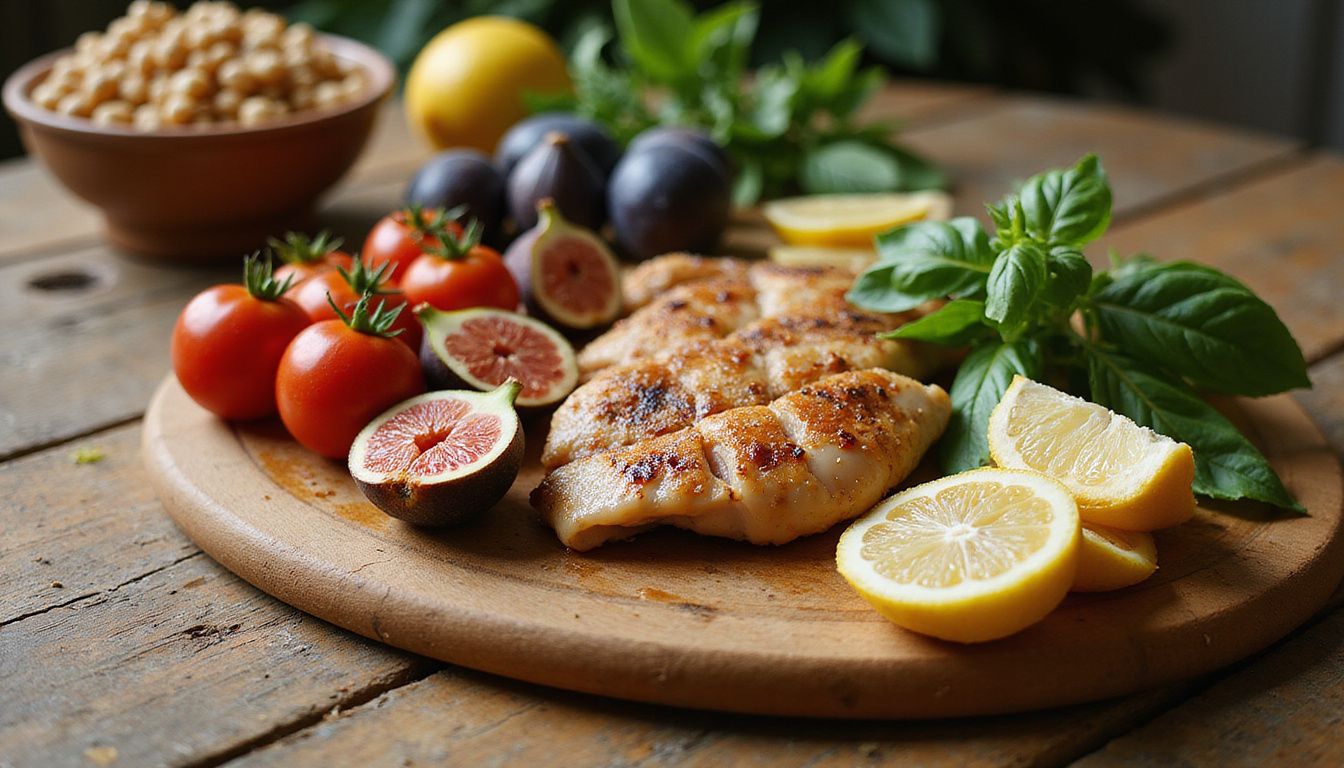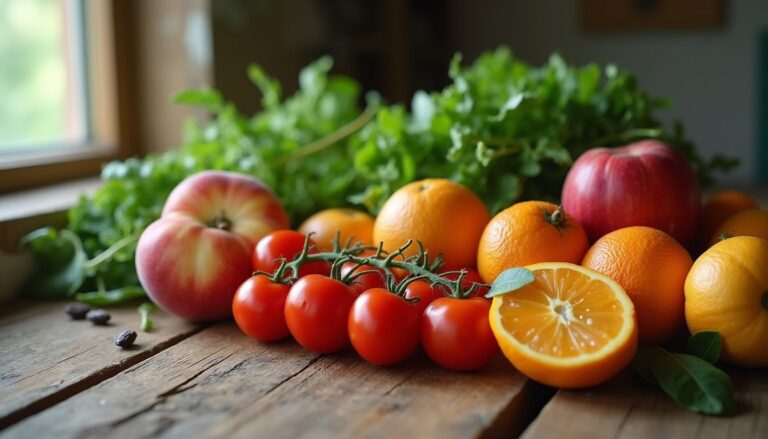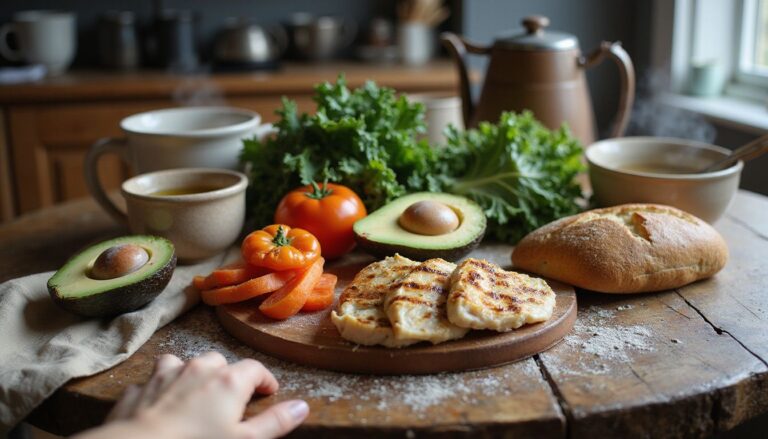7-Day Mediterranean Diet Plan For Beginners: Your Ultimate Meal Plan
Our Nutrition Assistant AI Suite will transform your body. You will lose fat, get toned, and build muscle. Gain confidence and optimal health.
Finding an eating plan that is simple, flexible, and good for heart health can feel confusing. I have been there too, sorting through endless advice and quick fixes. The Mediterranean diet is different. It centers on fresh produce, whole grains, beans, fish, and olive oil, and it fits real life.
In this guide, I explain the basics, the health benefits, and a clear 7-day Mediterranean diet meal plan for beginners. You will see what to eat, how much, and why it helps. Small steps build momentum. Try a few swaps this week, then add more as you feel ready.
Medical disclaimer: This guide is educational and does not replace personalized medical advice. If you have a health condition, take medications, or drink alcohol, talk with your clinician before making changes.
Key Takeaways
- The Mediterranean diet highlights fruits, vegetables, whole grains, fish, poultry, and extra virgin olive oil. Red meat is limited to one 3-ounce serving per week.
- Following this pattern can cut heart disease risk by up to 30 percent, lower cholesterol and blood pressure, and support weight control with sample days around 1,200 to 1,400 calories.
- Clinical trials, including the NEJM April 2013 study (Estruch et al.), report better weight and metabolic results than low-fat diets due to healthy fats and fiber.
- Common guidance suggests three weekly fish servings for omega-3s, daily use of extra virgin olive oil at one tablespoon per serving, and at least three servings of both fruits and vegetables each day.
- Meal plans avoid processed foods and sugary snacks, allow moderate dairy like Greek yogurt or cheese, and encourage social meals for enjoyment and mental well-being.
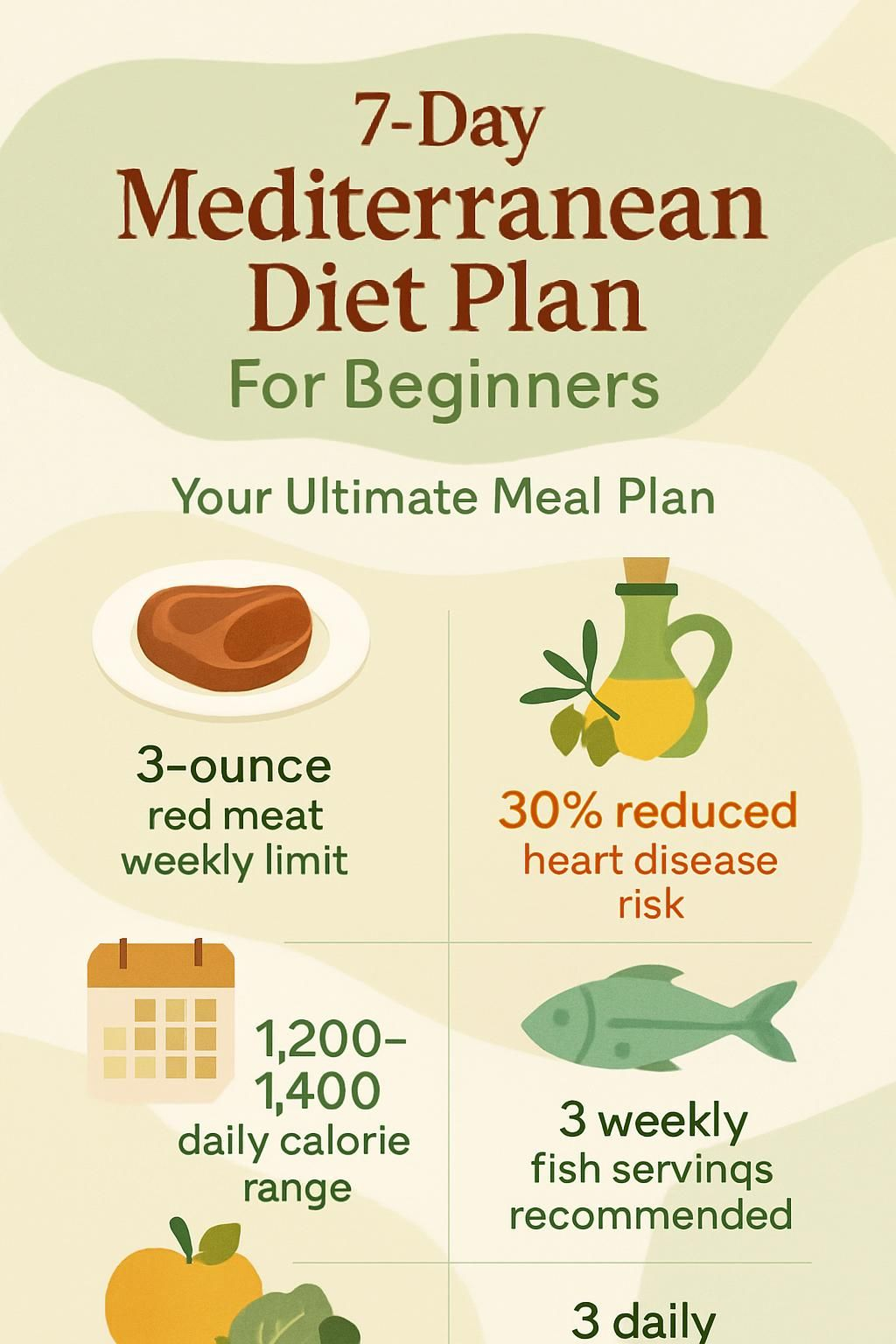
What Is the Mediterranean Diet and How Does It Work?
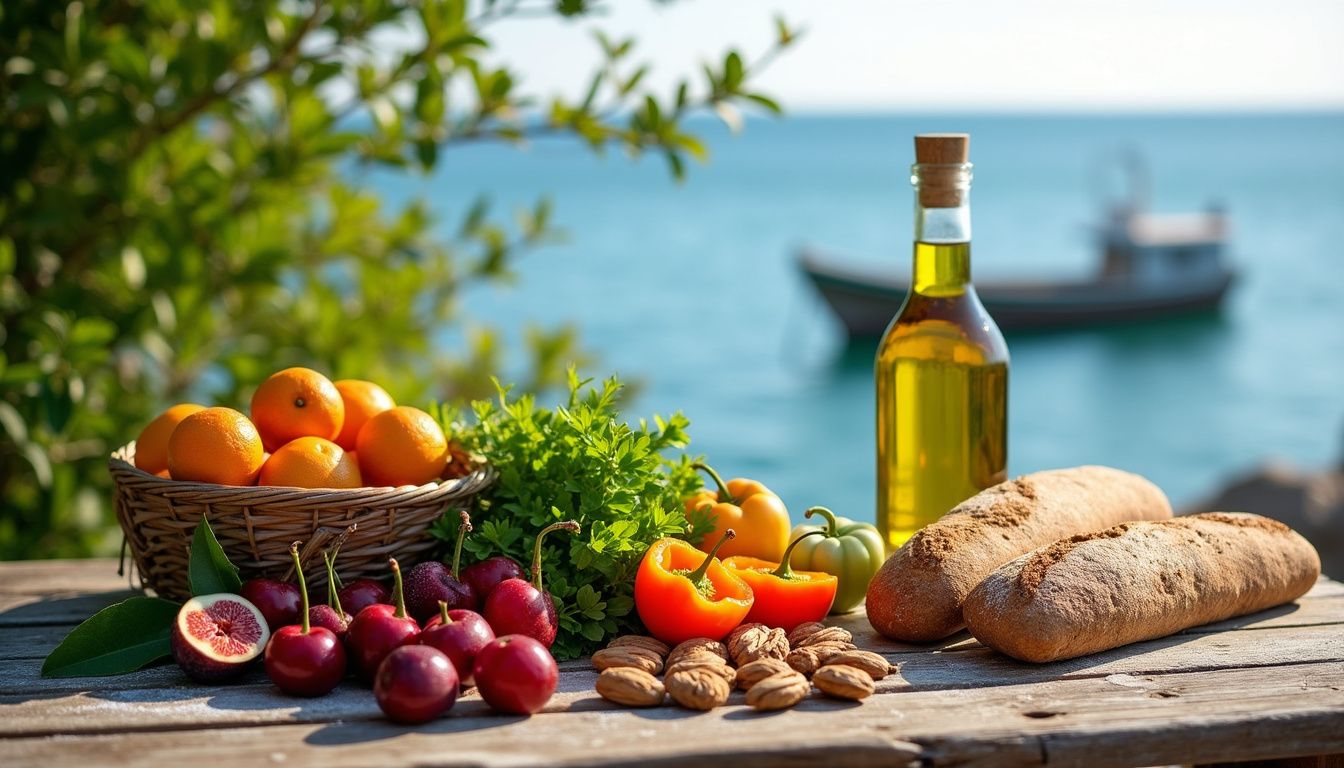
The Mediterranean diet reflects traditional eating patterns from countries bordering the Mediterranean Sea in the mid-20th century. It focuses on plant foods such as fruits, vegetables, whole grains, beans, and nuts, along with seafood and poultry.
Extra virgin olive oil, often called EVOO, is the main fat. Many experts recommend 1 to 4 servings per day, with one tablespoon per serving. People eat fish and poultry more often than red meat, and they keep processed foods low.
This way of eating does not ban food groups. It lifts up heart-healthy fats and nutrient-dense plants. It limits saturated fat and refined items that can raise the risk of disease.
Research links this pattern to better cholesterol levels and healthier arteries. EVOO provides monounsaturated fat, which supports heart health. Fish like salmon supply omega-3 fatty acids, which calm inflammation.
The plan feels flexible. It allows moderate dairy such as Greek yogurt or cheese. Some people choose a small glass of red wine with meals. These choices add flavor without much added sugar or refined carbohydrates.
Core Principles of the Mediterranean Diet
The Mediterranean diet favors simple habits that focus on plants, healthy fats, and fresh ingredients. These core ideas make it easier to eat well and stay consistent.
Why Should You Emphasize Plant-Based Foods?
Plant foods form the base of this diet. I aim for at least three servings of vegetables and three servings of fruit each day. A serving is about half a cup cooked or one cup raw for vegetables. For fruit, a serving is about half to one cup.
Plants provide fiber and antioxidants. These nutrients help lower the risk of heart disease, type 2 diabetes, and stroke. Legumes like beans and lentils support gut health and offer protein without the saturated fat found in red meat. I target at least three servings of legumes weekly, about half a cup per serving.
I feel more satisfied when my plate is packed with greens, apples, cucumber slices, or almonds. These foods have a low calorie density, so they help with weight goals while keeping meals flavorful.
What Are the Best Healthy Fats to Use Regularly?
EVOO is my go-to fat for cooking and dressings. It has more antioxidants than regular olive oil, which may protect cells and reduce inflammation. I use 1 to 4 tablespoons daily to meet common guidance.
Other healthy fats include avocados, nuts, seeds, and fatty fish such as salmon or sardines. These foods provide omega-3s that support heart and brain health and can help lower LDL, or “bad,” cholesterol. Replacing butter or margarine with olive oil keeps saturated fat low without losing taste.
Why Prefer Fish and Poultry Over Other Proteins?
Fish and poultry supply high-quality protein with less saturated fat than most red meat. Fish like salmon, sardines, herring, tuna, and mackerel are rich in omega-3s that support cardiovascular health. I aim for fish at least three times a week, 3 to 4 ounces per serving.
For poultry, I choose skinless chicken or turkey. I often grill or roast it for lunch or dinner, about 3 ounces per meal. This approach meets protein needs while keeping red meat in check.
How to Minimize Red Meat and Processed Foods?
I plan for red meat no more than once per week, choosing lean cuts such as tenderloin or sirloin. A serving is about 3 ounces. I also avoid processed meats and commercial baked goods, which are high in sodium, sugar, and additives.
Whole grains like barley and quinoa make easy meal bases. Eggs and cottage cheese offer satisfying protein without the risks linked to higher red meat intake. Nuts and olive oil replace less healthy snacks and fats, which supports blood pressure and heart health.
What Are the Benefits of Sharing Meals Socially?
Sharing meals with family or friends turns healthy eating into a pleasant routine. I find I eat more fruits, vegetables, and whole grains when I slow down and connect at the table. Conversation helps me notice fullness cues and enjoy food more.
Research ties social meals to better digestion, mood, and stress levels. A relaxed pace and good company make these habits easier to keep for life.
What Are the Health Benefits of the Mediterranean Diet?
This eating pattern supports long-term wellness through a smart food list and a focus on olive oil, nuts, and plants. Many people use it for meal prep because it is flexible and backed by evidence.
How Does It Enhance Heart Health?
Traditional patterns from the Mediterranean region are linked to fewer heart attacks and lower rates of coronary artery disease. The diet keeps saturated and trans fats low, which helps reduce LDL cholesterol and inflammation in arteries. Using EVOO instead of butter supports healthier cholesterol levels.
Foods like nuts, leafy greens, fish, and whole grains also support blood pressure control. Studies show this pattern can cut heart disease risk by up to 30 percent compared with diets high in red meat and processed foods. After I shifted to more seafood, salads with olive oil, and herbs, my blood pressure improved.
Can It Lower Chronic Disease Risks?
Healthy eating does more than support the heart. The Mediterranean diet may lower the risk of high blood pressure, metabolic syndrome, type 2 diabetes, and some cancers. A 2013 trial found lower rates of cardiovascular events, including heart attacks and strokes, among followers of this pattern.
Core foods include fruits, vegetables, legumes, nuts, whole grains, olive oil, fish, and poultry. People often see better cholesterol and improved digestive health. I notice steady energy when I build meals around these staples, for example grilled fish with dill or 1 cup Greek yogurt with orange slices.
Scientists suggest this diet supports a diverse gut microbiota and lowers inflammation, two factors tied to chronic disease risk.
Summary Table
| Disease Risk | Effect of Diet | Key Points |
|---|---|---|
| Cardiovascular | Reduced heart attack and stroke risk | Low saturated fat, limit processed meats |
| Metabolic Syndrome | Lowered risk | Plant-forward meals, higher fiber |
| Some Cancers | Decreased risk | High fruit and vegetable intake |
Eating more whole grains like couscous or barley bread can also support weight control, which further protects long-term health.
How Does It Promote Brain Wellness?
Antioxidants and healthy fats support brain function across the lifespan. EVOO contains compounds that may protect brain cells from inflammation and damage. Many Mediterranean diet recipes include these fats daily.
In 2023, researchers Agarwal P, Leurgans SE, Agrawal S, and colleagues reported in Neurology that older adults who followed a traditional Mediterranean pattern had less Alzheimer’s disease pathology. In simple terms, they saw fewer signs of the disease in brain tissue.
Meals built on plants, fish, eggs, and fruit can support memory and slow cognitive decline. Eating with others also helps mood and mental health, which matters for brain wellness.
Is It Effective for Weight Management?
I found weight control easier on a structured 1,200-calorie plan built on Mediterranean foods. Daily totals included at least 51 grams of protein and 30 grams of fiber. That mix kept me full and helped me skip mindless snacking.
Whole grains, nuts, fish, and poultry offer slow, steady energy with satisfying textures. A New England Journal of Medicine study reported better weight loss with the Mediterranean diet than with a low-fat diet.^1^ I added regular exercise and saw improvements in blood pressure and cholesterol too.
^1 Estruch R., et al., “Primary Prevention of Cardiovascular Disease with a Mediterranean Diet,” NEJM, April 2013
Which Foods Are Essential in the Mediterranean Diet?
The Mediterranean diet includes a broad mix of colorful produce, whole grains, nuts, legumes, seafood, and olive oil. These basics make meals nourishing and enjoyable.
What Variety of Fruits and Vegetables Should You Eat?
Fresh produce is central to this pattern. I aim for at least three servings of vegetables and three servings of fruit daily. Leafy greens like spinach, kale, and arugula bring vitamins A and C. Tomatoes add lycopene. Bell peppers supply vitamin C and antioxidants.
Berries go well with Greek yogurt at breakfast. Citrus fruits such as oranges support immune health. Potatoes, eaten with skin, provide fiber. Eggplant and zucchini roast well and work in salads. Choosing seasonal and local produce boosts freshness and often improves taste.
What Whole Grains Are Recommended?
I rotate oats, barley, quinoa, and brown rice. These grains have more fiber and nutrients than white bread or refined pasta. A serving equals half a cup cooked grains or pasta, one slice of whole grain toast, or one cup of dry cereal.
Whole grains can help with sodium control and cholesterol levels. Diets rich in these grains may also support brain health. Switching types during the week keeps meals interesting and supports the benefits of this approach.
How Do Legumes and Nuts Fit In?
Legumes and nuts are key sources of plant protein. I target at least three servings of legumes per week, such as beans or lentils, at half a cup per serving. I also include nuts like almonds or walnuts several times weekly. A serving is about a small handful or two tablespoons of nut butter.
Regular intake of legumes and nuts is linked to better heart health and a lower risk of chronic disease. They deliver fiber, healthy fats, vitamins, and minerals without much saturated fat. I like a chickpea salad with mint or whole grain toast with nut butter for simple, filling meals.
Why Choose Extra Virgin Olive Oil?
EVOO is the primary cooking oil in this diet. Many experts suggest 1 to 4 tablespoons daily. I use it for dressings, roasting, and drizzling over cooked fish and vegetables.
EVOO contains antioxidants that may reduce inflammation. People who use it regularly show better heart and brain outcomes in studies. Its rich flavor makes it easy to replace less healthy fats without losing taste or texture.
What Fish and Seafood Are Recommended?
Salmon, sardines, herring, tuna, and mackerel fit the plan well. These fish provide omega-3 fatty acids that support heart health. Aim for three servings weekly. Each serving is about 3 to 4 ounces.
I like grilled salmon for lunch and fresh mackerel for dinner. Varying the fish keeps meals interesting and helps meet weekly omega-3 goals.
What Foods Should You Limit on the Mediterranean Diet?
Limiting certain foods helps preserve the benefits of this plan. Focus on the swaps below to keep nutrition high and added sugars and unhealthy fats low.
Why Reduce Red Meat and Processed Meats?
Red meat is higher in saturated fat, which can raise LDL cholesterol and heart disease risk. I cap red meat at one 3-ounce serving per week and choose lean cuts like sirloin, tenderloin, or flank steak.
Processed meats such as deli slices, sausages, and hot dogs often contain high sodium and preservatives like nitrates. Frequent intake is linked to higher cancer and chronic disease risk. I feel more energized when I swap these for fish, beans, or poultry.
Which Refined Grains and Sugary Snacks Should You Avoid?
I skip white bread, white rice, and sugary cereals because processing removes fiber and many nutrients. Granola bars loaded with sugar fall into the same group. Commercial pastries, cookies, and cakes deliver lots of added sugar and little value.
Homemade desserts can fit if enjoyed sparingly. I limit sweets to three small servings per week. Keeping sugar low helps reduce the risk of diabetes and heart disease.
How to Cut Down on Saturated and Trans Fats?
I cook with EVOO instead of butter and keep dairy moderate. One serving per day works for me, such as 1 cup of low-fat milk or yogurt or 1.5 ounces of reduced-fat cheese.
Eggs fit the plan, though I keep yolks to no more than one per day, and no more than four per week if cholesterol is a concern. For snacks, I choose nuts, seeds, or fruit. That helps me avoid chips and packaged baked goods that often contain hidden trans fats.
Beginner’s 7-Day Mediterranean Diet Meal Plan Overview
This 7-day outline shows how to combine produce, whole grains, and lean proteins into tasty meals. I follow a simple structure to keep choices easy and satisfying.
What Does Day 1 Balanced Meals Look Like?
Breakfast: 1 cup nonfat plain Greek yogurt with 1/4 cup blackberries and 3 tablespoons walnuts. About 453 calories with plenty of protein and fiber.
Morning snack: 1/2 cup raspberries, about 39 calories.
Lunch: veggie and hummus sandwich, about 325 calories. Afternoon snack: medium pear, about 106 calories.
Dinner: sheet-pan roasted salmon with vegetables, about 422 calories. The day totals around 1,345 calories, with about 80 grams protein, 126 grams carbohydrates with 33 grams fiber, 64 grams fat, and roughly 1,088 milligrams sodium.
How to Focus on Fresh Produce on Day 2?
I center meals on fruits and vegetables. Breakfast and snacks feature clementines and oranges for vitamin C. Lunch is a Vegan Superfood Grain Bowl packed with colorful produce and fiber.
Dinner includes mixed greens with avocado and a vegetarian spring egg casserole. Day 2 reaches about 1,204 calories, 54 grams of protein, and 32 grams of fiber from produce and grains.
How to Integrate Healthy Fats on Day 3?
I add EVOO to salads and roasted vegetables. Breakfast might be Greek yogurt with blackberries or overnight oats, about 236 to 453 calories depending on the pick.
Throughout the day, I include avocado on sandwiches and sprinkle nuts over oatmeal or salads. Meals aim for at least 30 grams of fiber and 51 grams of protein. Almonds or walnuts make easy snacks that support heart health.
What Are Lean Proteins and Legume Combinations for Day 4?
I build meals that pair lean proteins with legumes. Options include bulgur salads like lemon-herb tabbouleh or charred broccoli tabbouleh. A quinoa and salmon salad delivers protein, omega-3s, and fiber.
Roasted chicken works well with cannellini beans. Chickpea and spinach pancakes provide plant protein and antioxidants. Black bean burgers bring potassium, magnesium, and fiber. Studies show that eating more beans can lower cholesterol by about 8 percent in eight weeks.
How to Include Whole Grains and Fiber on Day 5?
Breakfast: Cinnamon Roll Overnight Oats, about 191 calories, plus a clementine for extra fiber and vitamin C.
Lunch: Vegan Superfood Grain Bowls, about 381 calories. Dinner: Summer Shrimp Salad and Everything Bagel Avocado Toast, about 290 and 172 calories.
Day 5 totals about 1,246 calories, 60 grams of protein, 155 grams of carbohydrates, and 32 grams of fiber with just over 1 gram of sodium. High fiber supports steady energy and better digestion.
What Seafood Variety to Explore on Day 6?
I focus on salmon and shrimp. Salmon provides about 22 grams of protein per 3 ounces plus omega-3s for heart health. Shrimp is light yet rich in selenium and vitamin B12.
I enjoy grilled salmon with lemon or garlic shrimp over vegetables. These dishes help meet the weekly seafood target and keep meals interesting.
How to Conclude with Balanced Meals on Day 7?
Breakfast is Greek yogurt with blackberries and walnuts. For dinner, I make Strawberry Poppy Seed Salad with Chicken and serve Everything Bagel Avocado Toast on the side.
The day totals about 1,382 calories, 70 grams of protein, 131 grams of carbohydrates, 32 grams of fiber, about 1,200 milligrams of sodium, and 69 grams of fat. These choices close the week with nutrient-dense foods and consistent portions.
What Are Sample Daily Mediterranean Meals?
I plan simple meals with olive oil, lean proteins, whole grains, and seasonal vegetables. Building your day with these staples keeps food tasty and practical.
What Is a Healthy Mediterranean Breakfast?
I often choose steel-cut oats with berries and ground flaxseed for fiber and antioxidants. On other days, I have whole grain toast with nut butter and a fruit smoothie.
Greek yogurt with sliced fruit and walnuts offers protein and healthy fats. A veggie omelet adds extra produce. My breakfasts generally range from 236 to 453 calories and avoid added sugars and processed items.
What Are Good Mediterranean Snacks?
A handful of unsalted nuts or seeds, such as almonds or pumpkin seeds, keeps me full. Fresh fruit like figs, oranges, or grapes brings vitamins and natural sweetness.
I also like nonfat Greek yogurt with a small square of dark chocolate, at least 70 percent cacao, for extra antioxidants. Whole grain crackers with hummus add fiber and plant protein.
How to Prepare a Mediterranean Lunch?
I start with a base like bulgur or quinoa, then build salads such as lemon-herb tabbouleh or charred broccoli tabbouleh. I often add salmon to a quinoa salad since fish twice per week supports omega-3 goals.
Roasted portobello sandwiches with vegetable soup fit the plan and keep red meat lower. Whole grain pasta salad is great for make-ahead meals. EVOO replaces butter to boost healthy unsaturated fats.
What Snacks Complement the Diet?
Between meals, I choose raw vegetables like carrots, cucumbers, and bell peppers with Greek yogurt dip. Fresh fruit is another easy option with fiber and vitamins.
Greek yogurt with berries offers protein, calcium, and antioxidants in one bowl. A cup of yogurt with half a cup of strawberries has about 20 grams of protein and under 200 calories. Simple snacks based on whole foods work best.
What Does a Mediterranean Dinner Include?
Dinner highlights lean proteins, vegetables, and healthy fats. I make salmon with mango salsa or cod over lentils. Roasted chicken with cannellini beans is hearty yet balanced.
On meatless nights, I cook chickpea and spinach pancakes or a black bean burger on a whole grain bun. I add a side salad, such as sesame cucumber salad or mixed greens with an olive oil vinaigrette. For a lighter option, a homemade pizza with tomatoes and herbs also fits.
How to Prepare and Shop for Mediterranean Meals?
I plan weekly, write a list, and shop once to save time. A simple system makes daily cooking far easier.
How to Organize a Weekly Shopping List?
I group items by category so I can shop fast. Pantry staples go first: EVOO, salt, pepper, dried herbs, red wine vinegar, Dijon mustard, whole grain mustard, soy sauce, honey, and maple syrup.
Next, I add fresh produce, then whole grains like brown rice or quinoa, and legumes and nuts. I also plan for fish and poultry, which helps me avoid processed meats. This structure keeps my cart aligned with the plan.
Why Prioritize Seasonal and Local Produce?
Seasonal, local produce often tastes better and can be higher in some nutrients because it travels less. Shorter trips mean more vitamin C and fresher flavor.
Buying local also supports nearby farms and cuts transport emissions. In spring, I reach for strawberries or asparagus at the market. A 2022 study found people who eat mostly seasonal produce consume up to 17 percent more fiber. Seasonal food often costs less at peak harvest too.
What Pantry Essentials Should You Keep?
EVOO is the base for most recipes. I keep canned tomatoes, beans, quinoa, rice, pasta, and whole grain bread or pita on hand for quick meals. A stocked pantry makes healthy cooking easier during busy weeks.
Nuts and seeds add crunch and protein. Hummus works as a dip or spread. Whole grain crackers are helpful when time is tight. With these basics, I can assemble balanced meals fast.
What Are Common Questions About the Mediterranean Diet?
Many people ask how to adapt this plan to their needs. Here are straightforward answers to common questions I hear.
How Can Vegetarians Adapt the Mediterranean Diet?
Vegetarians can swap fish and poultry for beans, lentils, nuts, and seeds. I rely on chickpea salads and lentil grain bowls to cover protein needs. A quarter cup of almonds has about 6 grams of protein. One cup of cooked lentils provides more than 17 grams.
Extra virgin olive oil, whole grains like farro or brown rice, and colorful produce remain the core. If dairy is included, Greek yogurt adds protein and calcium. Plant-forward meals keep the diet interesting without animal meat.
Is the Mediterranean Diet Gluten-Free?
The Mediterranean diet is not gluten-free by default. Traditional bread and pasta often contain wheat. If you avoid gluten, read labels and choose naturally gluten-free grains like quinoa, brown rice, or corn.
I swap bulgur with brown rice for tabbouleh or use chickpea pasta instead of wheat noodles. Fruits, vegetables, legumes, nuts, fish, and healthy fats are naturally gluten-free, which makes adjustments simple.
What Is the Role of Wine in the Mediterranean Diet?
Wine is optional. Some guidance suggests women may have up to 1 small glass daily, about 3 ounces, and men up to 2. People who do not drink should not start for health reasons. Those who are pregnant, on certain medicines, or in recovery should avoid alcohol.
I sometimes pair a small glass of red wine with dinner on weekends. It feels like part of a slow, social meal, not a requirement.
Conclusion
A 7-day Mediterranean diet meal plan for beginners is a realistic way to build healthy habits. The focus is clear: colorful produce, hearty vegetables, whole grains, beans, seafood, poultry, and olive oil. These foods support heart health, brain health, and weight control.
I rely on Greek yogurt, salmon, beans, and fresh greens to keep meals satisfying. The plan is flexible, so it fits busy weeks and family life. Share meals when you can, keep processed foods low, and enjoy simple flavors. That is how this Mediterranean-style approach turns into a lifestyle that lasts.
FAQs
1. What is a 7-day Mediterranean diet plan for beginners?
A 7-day Mediterranean meal plan provides structured daily menus based on traditional foods from countries bordering the Mediterranean Sea. These plans emphasize vegetables, fruits, whole grains, legumes, nuts, olive oil, and lean proteins such as fish or poultry. Studies show this eating pattern supports heart health and weight management (Estruch et al., 2018).
2. How does the Mediterranean diet benefit health?
Research links the Mediterranean diet to lower risks of cardiovascular disease and type 2 diabetes (Martínez-González et al., 2019). The focus on plant-based foods and healthy fats helps reduce inflammation while supporting balanced blood sugar levels.
3. Can I follow a beginner’s meal plan if I have dietary restrictions?
Many people with food allergies or intolerances adapt the basic structure by choosing suitable alternatives within each food group. For example, those avoiding gluten can select gluten-free grains like quinoa or brown rice; individuals who do not eat seafood may use skinless chicken breast as their main protein source.
4. What are some practical tips for starting a Mediterranean meal plan?
Begin by planning meals around seasonal produce and whole ingredients rather than processed items. Prepare simple recipes using olive oil instead of butter; add beans or lentils to salads for extra fiber; choose fruit for dessert most days. When I first tried this approach, shopping lists helped me stay organized while learning new dishes that fit my schedule.
Summary: A beginner-friendly seven-day Mediterranean menu emphasizes nutrient-rich foods proven to support overall wellness according to scientific research. Flexible options make it accessible even with specific dietary needs; practical steps help ease adoption into daily life.
Sources: Estruch R et al., N Engl J Med (2018); Martínez-González MA et al., Nutrients (2019)

